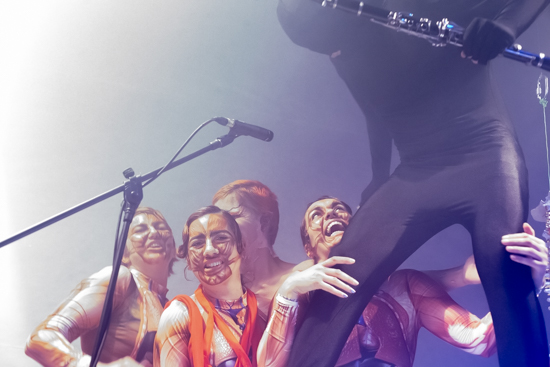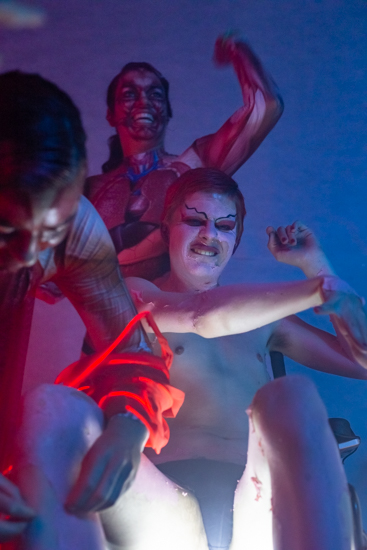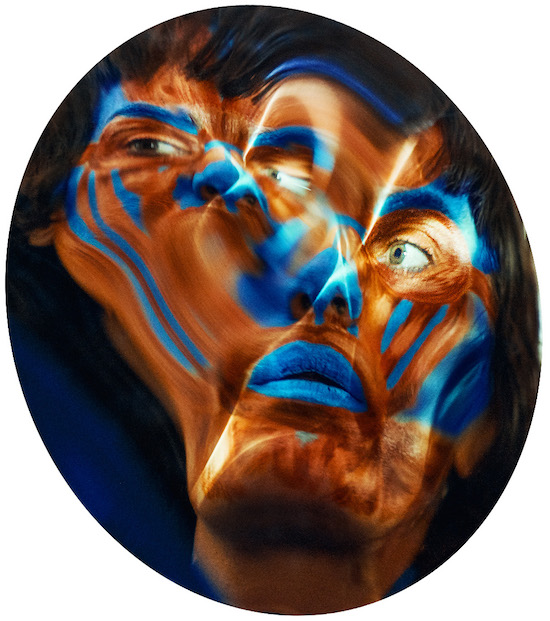Body Vice live photographs by Eleni Parousi and main portrait by Al Overdrive
Body Vice will be performed at Teeside Cyberpunk Convention on Sunday 10 November
“Do you want to hang upside down or do you want to have an electrical pulse going through your body?” asks Natalie Sharp. I hesitate. This is not the kind of question I have faced in my line of work before. I choose both.
The suspension rig, on a doorway in her upstairs landing, looks like a pull-up bar and puts you in traction, stretching out the spine as you are dangle from your ankles. Sharp shows me how to get up, moving a 5ft block of polystyrene out of the way (“I was going to carve a spine from it,” she says casually) and encourages me to let go of the support strap. When I do, all the questions I intended to ask as I dangled fall out of my head, replaced by blind panic. There is a reason most of us are not in the habit of hanging upside down. It is very unpleasant. Sharp is supposed to do this for 20 minutes a day, to ease the pressure on her spine and therefore the pain in her back. I ask to get down immediately, and opt for electrocution, administered with a pen that is a sort of mini TENS machine, ‘a convenient way to self administer low voltage therapy’. The idea is that, like a TENS machine, it shoots electricity through muscles to stop you tensing up, and relieves pain by momentarily displacing it with an electric shock.
Both of these things are devices tried as solutions, silly and serious, to ease her chronic back pain, which is the subject of her current show, Body Vice. The show is an archetypical multi-media assault that includes music, video, sound, performance art, costumes, custom-built instruments and a rotating cast of performers, this time with faces painted in anatomically correct muscle structures, in body suits to match. It is the follow up to the gluttonous splooshing of Trifle (which was performed with her band Lone Taxidermist) but visually and sonically it is an entirely different proposition.
Sharp once described Trifle succinctly as like “being inside Pat Sharp’s fun house with a bit of Handmaid’s Tale and Leigh Bowery”, and in this vein, Body Vice is like a combination of Casualty as directed by Gunther von Hagens, with a bit of Neuromancer and a probing medical questionnaire – the latter literally transposed as spoken word. Structured as scenes, it moves from mechanical examinations to ecstatic pain, from the controlled to the chaotic, finishing with something which is both climax and distraction, as a figure in a black second skin jumpsuit is wheeled in atop a gurney, squealing on a clarinet amid a cacophony of electronic sound. It is a release, but only for the audience.
“I wanted to do something up tempo and banging,” she says. “It’s in that bit I start to vomit out my pain – where I’m giving out, not receiving.”
At the core of Body Vice are Sharp’s regular collaborator flautist Tida Bradshaw, who at one point unfurls an illuminated plastic nervous system from inside her body suit to pass around the audience, and instrument builder and noise musician Tara Pattenden (aka Phantom Chips) who has helped her create the ‘skinstruments’ for the show – a pair of disembodied anatomically correct spines made into instruments that trigger a collection of samples.
The show is still in its growth stages, meaning new people are occasionally added on the fly – at this summer’s Supernormal festival, tQ editor John Doran, dressed in a hospital gown and summer hat, read a piece on the sound of MRI scanners and appealed for quotidian panic buttons. A girl called Rosie was invited in to tear off layers of skin, painted on as pink latex body paint. “We bumped into Rosie and she said ‘I really like you. But you don’t follow me on Instagram’” says Sharp. “Then she just took her eye out and placed it on her hand – a fake eye! In the shape of a heart! I asked her if she wanted to be in Body Vice immediately, if she could come and tear her skin off and throw it into the crowd.”

Body Vice is also a different way of approaching an audience. “It’s very different to Trifle, because I’m not trying to attack the crowd – I’m sort of attacking myself – it’s more about self-interrogation than trying to take the crowd by surprise. A good reaction is when someone comes up to me afterwards and says, ‘I could actually physically feel the pain in my body’. Or someone from the NHS, said it was such a massive relief that someone’s doing something to do with the NHS and pain. A bad reaction is always indifference.”
For Sharp, part of the purpose of Body Vice is to articulate what is hard to put into words. “There isn’t really a language for this experience,” she says of chronic pain. “I don’t know how else to try and represent it,” she says. Her pain is in her back – an injury related to osteoarthritis in her left ankle, which she’s had since she was a teenager, and the accumulated stress of lugging around gear, and the repeated twisting and leaning of years of professional make-up and face-painting work. Around three years ago, something went seriously wrong on stage, and since then she has been in constant pain. “My body had a spasm on stage at Tremor festival in the Azores, and the right hand side of my body and my back just went completely. I was on the floor in massive, massive agony,” she says. “Everyone just thought it was part of the show. I was on the floor, in a kind of semi-baby pose. Moving myself at all to get up was almost impossible. I don’t even remember how I got off the stage.”
Someone carried her, she thinks, and helped her into a chair backstage. “I remember being in the back room, and I was stuck in a sort of fetal position – this whole side of my body had just gone – any move any movement just caused absolute agonising pain.”
Back at the hotel she stayed up all night ramping up the voltage on the TENS machine she had been using to help with the ache that was now full body collapse. “I’d never got it up any higher than about a level four,” she says. “But I had it on seven. I couldn’t get into the hotel bed, I was just in a tabletop position until about five in the morning, electrocuting myself all night.”
For a period afterwards, it was unclear if she’d be able to perform music again, and she became consumed by the pain. “I didn’t have any identity,” she says. “I was just a big bag of pain, and that was all I was – my whole waking consciousness was obsessed with pain, everything from getting out of bed, going to the toilet, opening the fridge door. It was horrendous.”

Since then Sharp has been passed through various specialist units, and received multiple diagnoses, but more recently has been referred to a pain therapist by the NHS, who advises on strategies to deal with long-term chronic pain. “It is about accepting that you might have this pain in your body for the rest of your life, and being all right with that,” she explains. “When she first told me this, I said no fucking way, I don’t want to accept that – I don’t want to be in pain the rest of my life.”
The litany of fixes she’s tried results in me trying to ask questions as my lip involuntarily curls into an Elvis snarl, as pins of electricity shoot through my face from the mini TENS pen. It is surprisingly powerful, more than just tingly, but is only a fraction of the power of the TENS machine set to seven. Sharp has embraced a litany of fixes and pain relievers – she explicitly enjoys exploring the mad edges of beauty devices anyway, and if there is a link to Trifle from Body Vice it is this fascination and interrogation of the ways in which we alter and treat our bodies. In Body Vice, it is the medical which is the focus, rather than the grotesque. Also like Trifle, this show is expanding as it is performed, although the initial vision for it was wildly adventurous. “Initially, I was pulling out ideas left, right and centre,” she says. “I was researching all kinds of stuff – magnetic ferrous fluids, AI. I wanted to go off and work with a radiologist; I wanted to make the room magnetic; I wanted people to dress up as human projector screens and project on them; I wanted a massive hospital curtain.”
From the initial scratch list, two of the most striking elements that have survived are Sharp’s ‘skinstruments’ and the sound of MRI scanners. Her ‘skinstruments’ are two anatomically correct spine instruments built by Pattenden, and which offer a direct and tactile means to engage with a literal representation of the source of her pain.
Sharp switches it on, and when I touch the contact points – a copper switch the size of a cigarette butt that juts from the bone – the connective tissue lights up, and a sample is triggered at random. I tinker, and find a juddering mechanical sound, fizzing, a bloop. There’s also sneezing and the sounds an MRI scanner, the latter of which forms the musical framework and inspiration for the project – that puts the ‘device’ in Body Vice. MRI scanners are loud, dense, unpredictable, and have humming, growling bass and clunking, fizzing top notes. My experience of being in one was like hearing a Pan Sonic set from inside a tube. “On some of [Body Vice] I was trying to mimic the sound, and I would just naturally go into a more rhythmic passage,” she says. “But then when I listened back to the scanner, it’s not like there’s no real tempo, it’s really scattered and unpredictable.”
MRI scanners are switched on all the time, and are cooled with liquid nitrogen, which makes a sound like breathing, or gasping, Sharp explains. When they are switched off at the end of their life, the sound “is like a death,” she says. “They’re never the same twice, which adds to the feeling that they’re somehow alive.”

The first time Sharp had an MRI scan was just out of her teens, and it on her ankle. They told her to bring a CD with her to play in the room while the machine scanned her leg below the knee. She took Simon & Garfunkel, and did not enjoy the experience. It was only around three years ago that she was inserted full into a scanner lying down, at a time when lying on her back caused immense pain, but the sound and feeling was a revelation. “I felt like my insides were just wobbling, like there was someone trying to get out of me, “ she says. “It’s really claustrophobic. They’re about two Tesla, the magnetic force, which is insanely strong – the magnetic pull of the Earth is something like 0.5.”
She has since become obsessed with magnetism, finding out how hovercrafts work; the tech behind the Japanese bullet train, and lens law, which inverts polarity on two objects so that one levitates. “I wanted to do something where you give people can get these posture belts that have got magnets going down the spine to correct your posture. I was going to give them to people when they came into the show, then work out a way of trying to magnetise the people to each other. Then I was thinking about making the walls magnetic and switching them on. But it’s always dangerous territory with magnets,” she sighs. “You’re not supposed to travel with them or anything, they fuck up electricity.”
The scanners became a source of inspiration not just because of their sounds, but the physical experience of being inspected by this seemingly living machine. “There’s something really sexy about being inside this really seriously overpowering machine that is assessing you and slicing you up from every imaginable angle. And you just have to sit there very still and very silent. I find sex in everything, but I do find the process of being examined by machine quite erotic.”
Sharp has worked as a face-painter since she was a teenager. This does not mean painting tiger faces at children’s parties, but jobs that have included painting legendary record sleeves on people’s faces for Record Store Day, face-art for the Olympics, and more recently has involved collaborations developing visual identities with Jenny Hval and Gazelle Twin, who she also performs with. Lone Taxidermist emerged a decade ago, and her first gig “was a disaster”. “There was no lighting or anything, I just thought, right, I’m gonna buy everything – I need to do this gig. But it was too much. I had a panic attack on stage and forgot everything. My face was painted and it was raining, and I ran outside and all my face melted off. I didn’t know what I was doing.”
From there she worked on her setup, bought a Roland 505 and learned to use it with Phil Winter, who became a core other member of Lone Taxidermist, and moved on to combine her performance art, costumes and face painting with samplers, synths, and Ableton. “Experimental music doesn’t end at the music part,” she says. “Why not apply that experimentalism to every other facet of the way that you’re making your art?”

Artistic questions, physical questions, and basic access questions come together in Body Vice. It’s not about respite from her pain, or a celebration or reclamation of the body, but nor does it dwell on the despair of such a physical state. “There’s not a language for chronic pain,” she says, describing Body Vice as an attempt to communicate something about her physical experience.
There is an irony in the fact that she’s sometimes struggled to be granted basic support in live shows, where she’s been booked to perform a piece explicitly made about her own chronic pain. At a recent festival performance at End Of The Road, she had sent access requirements ahead, which included needing help lifting her gear, and having somewhere to sit down, “but it just fell on deaf ears,” she says. These fairly simple requests were not fulfilled until someone from the BBC Late Junction stage (who had booked her) made the same demands on her behalf. “Because I don’t have a visual aid, I have to go back to explaining myself,” she says. Part of this is also about status, and the benefits of being able to afford a manager – she recalls supporting Einstürzende Neubauten and being bumped to a different stage’s dressing room because the group had a whole dressing room “just for juicing – a room full of vegetables with a Nutri-Bullet”.
These access issues, often as simple as needing to know there’ll be a chair (she won’t go if she knows there won’t be one, at club venues for example) led to her sending out a tweet asking for responses from musicians who consider themselves disabled or with chronic pain, with the idea of putting together a contract for promoters, festivals and venues regarding accessibility provisions. The response was so overwhelming she couldn’t reply to everyone, and ended up contacting Help Musicians and BAPAM (for artists who need access to healthcare), and an organisation called Attitude Is Everything, who provide support for musicians with the full gamut of access requirements and disabilities.
As for Body Vice, it has a conflict at its heart, as performing can worsen her pain. “I did a show on my own at a festival called The Delaware Road, and I put a lot of myself into it physically – flailing around and screaming. It was excruciating afterwards, but during the show itself I was doing some sort of exorcism, something I hadn’t really done before, I scared myself a bit. Since then I’ve noticed I’ve had more constant pain. I do feel a bit at odds with how to perform it – I might just start rocking up in a wheelchair with a USB stick.”
Body Vice is part objectification of her pain, and an interrogation of it, but it’s not asking for your sympathy. I put it to her, as she eases herself stiffly out of the chair she’s been sat on while we talk, that despite being in pain all the time and her visible discomfort, when she describes the acuteness and severity of the pain, she’s not complaining, but describing. Considering that solutions and treatments – from hanging upside down to electrocuting yourself – are both unpleasant and only offer mild relief, never a cure, she has not moaned about it once in the last three hours. “Moaning?” she puzzles. “There’s nothing to moan about,” she says, adding “well, obviously, there’s loads to moan about. But it’s boring isn’t it, moaning. I’m just always feeling blessed.”
Body Vice will be performed at Teeside Cyberpunk Convention on Sunday 10 November


